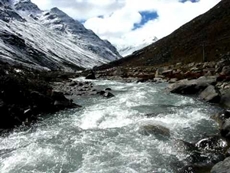Climate change deteriorates water quality in the Himalayas
09 Apr 2016
A new study by Lappeenranta University of Technology (LUT) on the climate change and geochemical processes of waters and lake sediments on the Tibetan Plateau shows that global warming affects geochemical processes such as glacier melting, soil erosion and sediment release.
 This deteriorates the water quality of rivers and lakes, thus significantly impacting the lives of 40 per cent of the world's population living in the area.
This deteriorates the water quality of rivers and lakes, thus significantly impacting the lives of 40 per cent of the world's population living in the area.
According to the results, concentrations of mercury, cadmium and lead in high-altitude lake sediments exposed to less human activity were significantly higher compared to low-altitude areas where more people live.
This finding indicates the atmospheric long-range transportation and deposit of pollutants to remote areas of the Himalayas. Precipitation during the monsoon season in the region has a high concentration of nutrients, which implies that atmospheric pollution is possibly being transported to the Himalayas from South Asia by the India monsoon, meaning that human activities in the surrounding area affect the waters of the Tibetan Plateau.
The research also found that arsenic concentrations in rivers in the Southern Tibetan Plateau were higher than the guideline for drinking water set by the World Health Organisation (WHO) due to the existence of thermal springs in this region.
The Tibetan Plateau has an extensive permafrost cover which stores a significant amount of carbon.
The temperature in the area has been increasing for the past 500 years and the climate on the central plateau has warmed more than in other regions in the past century. The rise in temperatures triggers the export of old carbon stores from ancient permafrost into contemporary rivers on the Tibetan Plateau.
Global warming will continue to release more carbon into the water system, which will, in turn, intensify the regional climate change and affect water quality.
The Tibetan Plateau is the highest plateau on earth and is also known as the "Third Pole" and "water tower of Asia". Water quality is an essential issue for the inhabitants around the Himalayan area. The water quality in the region is threatened by climate change as well as by human activities, as the world's two population-heaviest countries, China and India, are located in the area. However, local citizens' awareness of climate change, its impact on water quality and its mitigation actions is very limited. Researchers analysed the impacts of climate change on the water quality of the lakes, precipitation, as well as headwaters in three major Asian rivers on the Tibetan Plateau: the Yangtze, Yarlung Tsangpo and Ganges Rivers.
Professor Mika Sillanpää, the director of the project, calls for urgent research to understand the carbon cycle in the Himalayas.
"Global warming is releasing increasing amounts of carbon matter from permafrost into waters and then into the atmosphere. This will intensify the regional and even global climate change. It will affect livelihoods, rangeland degradation, desertification, the loss of glaciers and more," says Sillanpää.













.jpg)






.jpg)









